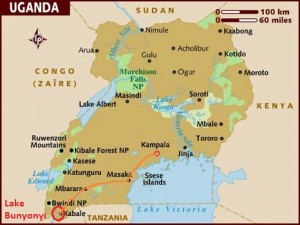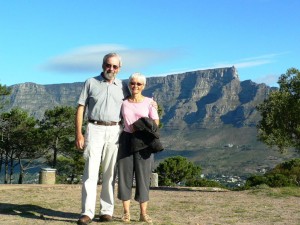Lake Bunyonyi
May 21st, 2012 One more jaunt before we leave Uganda for now. Our new rep arrived the first of May and is now taking over. So we took a long weekend to visit Lake Bunyonyi. We had earlier seen the Lake from mountains above when we drove to Rwanda in November. We knew we wanted to return to explore it more even though it is a 7 hour drive from Kampala.
One more jaunt before we leave Uganda for now. Our new rep arrived the first of May and is now taking over. So we took a long weekend to visit Lake Bunyonyi. We had earlier seen the Lake from mountains above when we drove to Rwanda in November. We knew we wanted to return to explore it more even though it is a 7 hour drive from Kampala.
We left our car at a secure site near the lake and took a boat to our lodging—Jajama Panorama. The “resort” is located on the side of a hill overlooking the lake. Such beautiful views! This is at the end of the low tourist season and we were the only ones staying; we had personal treatment! Mercy served as our host and cooked delicious meals and Martin kept the wood fire going so that we would have hot water.
Lake Bunyonyi, located about 6000 feet altitude, is surrounded by mountains rising up to 7500 feet. It is considered the second deepest lake in Africa and is one of the few freshwater lakes in East Africa that is considered safe (disease-free) for swimming. We didn’t swim even though it looked inviting. We did paddle our own dugout canoe two mornings looking for birds and enjoying the scenery and the peacefulness. “Lake Bunyonyi” means “place of many little birds.” We saw quite a few birds and were able to photo some of the larger ones.
We hiked around the resort. It rained during our first night so some of the paths were a bit slippery. Ron waited at the bottom of one small decline as Sally Jo came sliding down!
One afternoon Sally Jo hiked up the hill and along the terraces and hilltop. She was “guided” by two primary school boys. This is a highly fertile area and farming is done on terraces. She saw much maize, Irish potatoes, sweet potatoes, and green beans growing. She also went out to a point where much of the lake was visible—it is a long narrow lake with many inlets and many islands. One island is named “Punishment Island.” [The Bakiga (ethnic group in this area) used to leave unmarried pregnant girls on this small island with a lone tree – to die of hunger or while trying to swim to the mainland (swimming skills were rare). This was to educate the rest, to show them not to do the same. A man without cows to pay the bride price could go to the island and pick up a girl. The practice was abandoned in the first half of the 20th century. –from Wikipedia, though we heard the story numerous times.]
We very much enjoyed the relaxing few days—scenery, birds, water, games. Now to the final days of packing, one more all-day meeting, and final good-bys. It has been a good 15 months here.















































































































































































